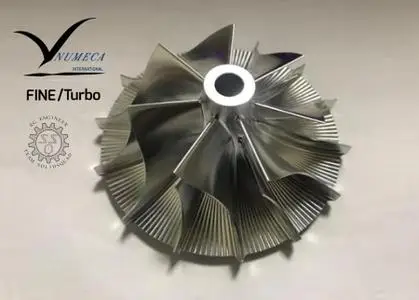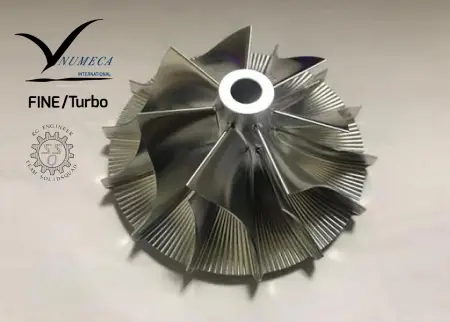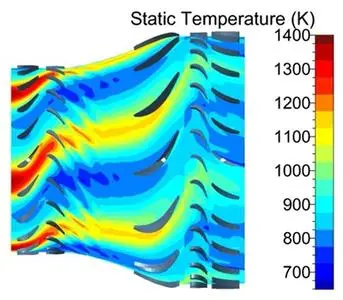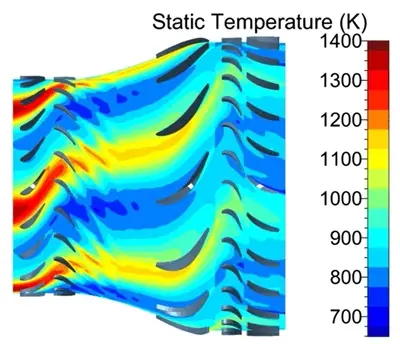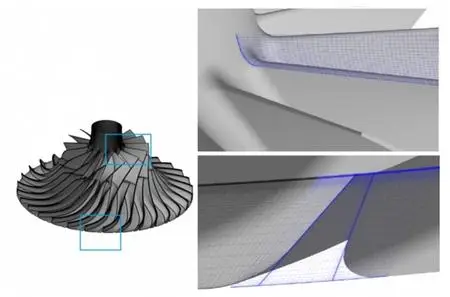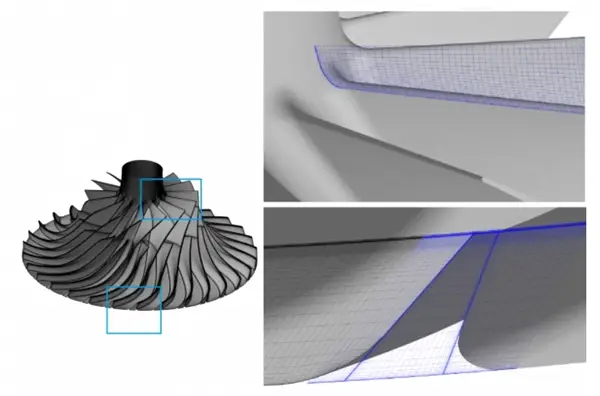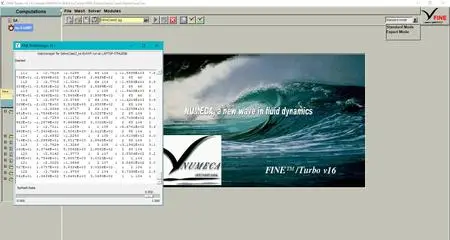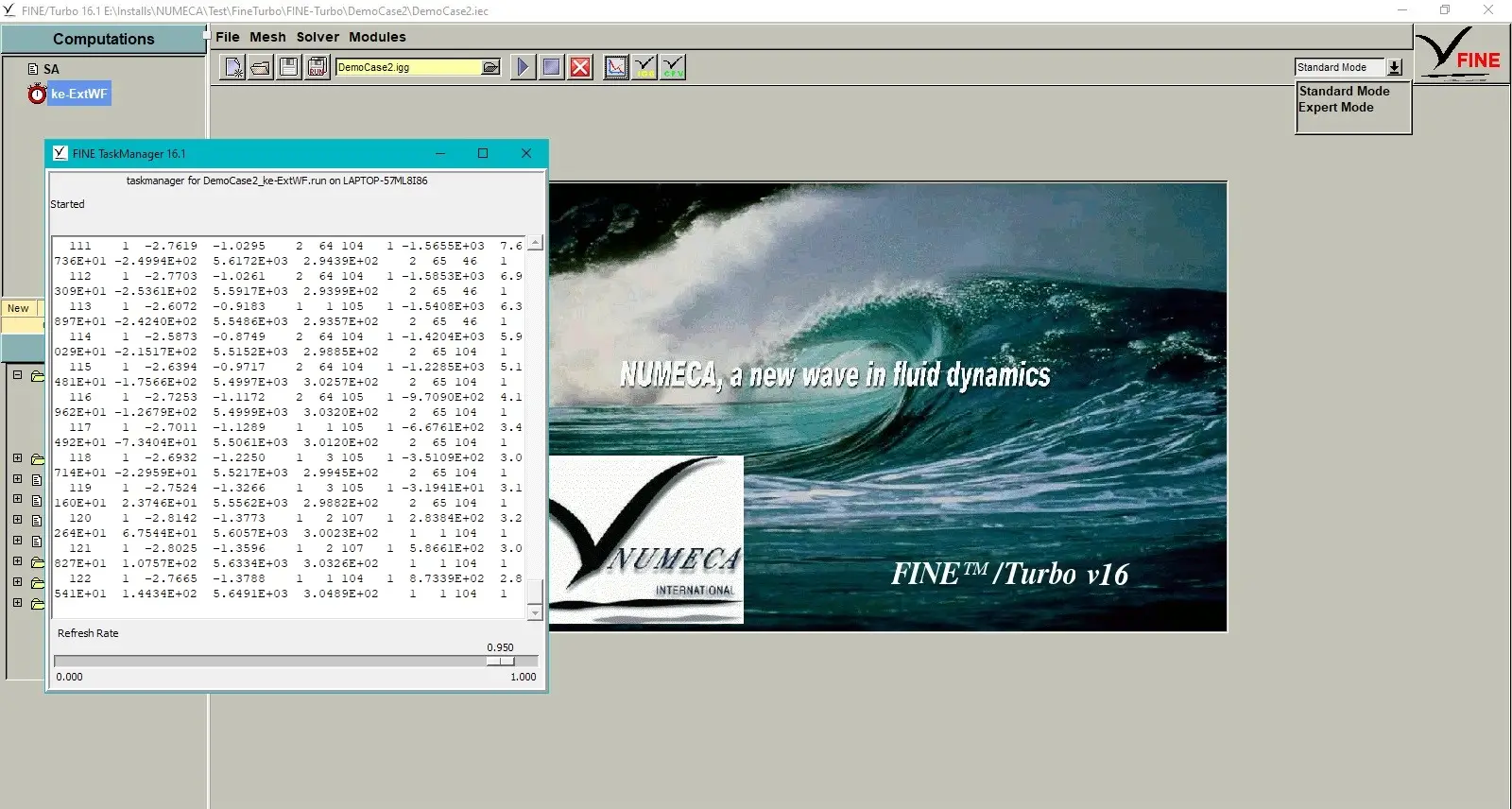NUMECA FINE/Turbo 16.1 | 6.3 Gb
NUMECA is delighted to announce the official release of FINE/Turbo, FINE/Design3D and FINE/Agile version 16.1. This release focuses on letting you work faster than ever before through new workflows and numerous performance enhancements.
FINE/Turbo - Limitless NonLinear Harmonic method with the rank-N
The NonLinear Harmonic method is a unique feature of FINE that has quickly become a staple among turbomachinery design engineers. It provides accurate modeling of periodic unsteady disturbances throughout a turbomachine - information typical of URANS simulations, but several orders of magnitude faster.
Initially designed for flow interactions across a single Rotor/Stator interface, this approach has proven to be invaluable for the analysis of any sort of rotating machinery, from volute pumps to multi-stage turbines. It has been successfully extended to clocking effects, rotor-rotor effects, inlet distortions, Fluid Structure Interaction (FSI) and more…
With rank-N, the NLH method allows simulating the effect of periodic disturbances across N rotor/stator interfaces, giving the designer complete freedom and flexibility on what, where, and how a flow perturbation is simulated.
AutoGrid5 – a new approach for impellers with blunt blades
Most impellers are built using a traditional subtraction manufacturing process: a milling machine uses a cutting tool to form the blade surface in one or more passes. This technique allows for high flexibility and quality of the finished part, but each blade has to be defined by a relatively large fillet radius and a trimmed profile.
The newest mesh topology in AutoGrid5 accurately replicates the fillet’s and blade’s actual geometry, without sacrificing mesh quality thanks to the so-called “butterfly” topology. The trailing edge of the impeller is connected to the next block by a non-matching connection to prevent distortion of cells downstream of the trailing edge.
FINE/Agile – Latest models and tools for the most effective design
FINE/Agile 16.1 includes the latest release from Concepts NREC (version 8.9), with numerous improvements and fixes for a better preliminary and detailed design: from new models for choke prediction in difusors in COMPAL, to the ability to design and analyze mixed-flow turbines in RITAL.
The resolution of Computational Fluid Dynamics (CFD) problems involves three main steps: spatial discretization of the flow domain, flow computation, visualization of the results.
To perform these steps NUMECA has developed three software systems. The first one, IGG, is an Interactive Geometry modeller and Grid generation system for multiblock structured grids. The second software system, the FINE/turbo solver, is a state of the art 3D multiblock flow solver able to simulate Euler or Navier-Stokes (laminar or turbulent) flows. The third one, CFView, is a highly interactive Computational Field Visualization system.
These three software systems have been integrated in a unique and user friendly Graphical User Interface (GUI), called FINE/Turbo, allowing the achievement of complete simulations of 3D internal and external flows from the grid generation to the visualization, without any file manipulation, through the concept of project. Moreover, multi-tasking capabilities are incorporated, allowing the simultaneous treatment of multiple projects.
FINE/Turbo has the particularity of integrating the concept of multi-tasking. This means that the user can manage a complete project in the FINE/Turbo interface; making the grid using IGG, running the computation with the FINE/Turbo solver and visualizing the results with CFView. Furthermore, the user has the possibility to start, stop and control multiple computations.
To manage complete flow analyses, FINE/Turbo integrates the concept of project. A project involves grid generation, flow computation and visualization tasks. The results of each of these tasks are stored in different files that are automatically created, managed and modified within FINE/Turbo.
FINE/Turbo Highlights
Numeca International Inc. is a leading developer and provider of Grid Generation, Multi-physics – CFD software systems for analysis, design, and optimization of industrial products and processes, with an emphasis in the domains of turbomachinery, marine, aeronautics, aerospace, energy, chemical processes and multi-physics. NUMECA offers an extended suite of software systems covering a broad range of applications for both internal and external flows, including fluid-structure, fluid thermal, aero-acoustic interactions.
Product: NUMECA FINE/Turbo
Version: 16.1 with Documentation & Tutorials
Supported Architectures: x64
Website Home Page : www.numeca.com
Language: english
System Requirements: PC / Linux *
Size: 6.3 Gb
Supported platforms and operating systems
NUMECA software is supported in 64 bits on x86_64 processors only (64 bits processors that are compatible with Intel 8086 set of instructions).
Formally tested on (Windows)
- Windows 8.1 Professional
- Windows 10 Professional
Formally tested on (Linux)
- Fedora Core 32, 28
- (K)Ubuntua 20.04, 18.04
- CentOS 7
Please also notice that the following limitations apply:
- Computations under Windows (except Windows Server) are limited to one PVM daemon running at a time. As a consequence, access to multiple users on a given machine is not allowed,
- Parasolid uses SSE2 instruction for high performance. If your platform is not supporting the SSE2 instruction, the FINE GUI cannot be started.
- AMD EPYC and RYZEN processors are slower on Windows 10 compare to Linux.
……………………………………………………………………………….
Multiprocessors calculations
Multiprocessors calculations are allowed on shared and homogeneous distributed platforms. Non-homogeneous configurations are not allowed.
The following limitations additionally apply:
- Multiprocessors calculations are allowed on distributed platforms in local user configurations provided that the same account is used for all machines,
- Domain administrators are not allowed to run multiprocessors calculations.
- MPICH2 library needs Microsoft .net Framework package before installing NUMECA software otherwise execution of mpiexec.exe will lead to a Windows error message.
…………………………………………………………………………………
Hardware requirements
Next to the standard hardware (monitor, keyboard and mouse), some specific recommendations apply in the use of NUMECA software:
- a mouse with scroll wheel is strongly recommended.
- the monitor should support 24-bit color graphics and have a 1280 x 1024 pixel resolution for adequate visualization.
- an Ethernet card should be installed and properly configured.
- NUMECA Software does not support CXFS (Clustered XFS) and IBRIX disk file systems. (Windows)
…………………………………………………………………………………
Memory and disk space requirements
The Random Access Memory (RAM) required to run NUMECA software depends upon several factors, in particular including the number of grid points inserted in the grid, the physical models selected (turbulence, adaptation,…), the introduction of non-matching boundary conditions and the selected calculation mode (mixed or double precision).
Similarly, a minimum disk space is required on the hard disk to allow the storage of the project files. The size of these files largely depends upon the number of grid points generated.
More product specific details:
FINE/Turbo
As a general guideline, a minimum 100 MB is required to store the mesh and solution file (one file, no full non-matching connections, solution stored after one iteration) when running a one million nodes project.
The memory (RAM) required to run FINE/Turbo depends upon several factors, in particular including the number of grid points inserted in the grid, the physical models selected (turbulence, optional modules,…) and the introduction of non-matching boundary conditions. The use of minimum 1 GB RAM is strongly recommended. As a general guideline, about 0.5 to 0.7 GB RAM are generally required to run a one million nodes project. Furthermore, the FINE/Turbo solver has a memory limit of 8.59 GB per process. This is thus the maximum memory requirement for a sequential computation. The suggested swap space should be equivalent to at least 3 times the RAM installed
IGG/AutoGrid5
The memory (RAM) required to run IGG/AutoGrid5 depends upon several factors, in particular including the number of grid points inserted in the grid. The use of minimum 1 GB RAM is strongly recommended. As a general guideline, about 0.5 to 0.7 GB RAM are generally required to run a one million nodes project. The suggested swap space should be equivalent to at least 3 times the RAM installed.
As a general guideline, a minimum of 50 MB is required to store the project files (geometry not defined by Parasolid™ or CATIA v5 files) for a one million nodes project.
CFView
The use of minimum 1 GB RAM is strongly recommended. As a general guideline, about 250 MB RAM are required to visualize a one million nodes project. The suggested swap space should be equivalent to at least 3 times the RAM installed.
No specific disk space is required on the hard disk for CFView except if images or data files are saved or if the meridional average is created in CFView (turbomachinery application).
…………………………………………………………………………..
Graphics requirements
NVidia graphics cards are fully supported, installed together with the latest drivers.
NUMECA software makes use of the advantages of the available Graphics Card. Some trouble may however come up with the default driver OPENGL since it may not be supported by the user host computer and machine display. In order to set the system compatible with a more portable driver, typically MSW driver is used under Windows instead. Note however that the proposed drivers are usually less efficient in terms of graphical speed than the default driver. (Windows)
NUMECA software makes use of the advantages of the available Graphics Card. By default, the driver OPENGL is used. (Linux)
NUMECA software is supported in 64 bits on x86_64 processors only (64 bits processors that are compatible with Intel 8086 set of instructions).
Formally tested on (Windows)
- Windows 8.1 Professional
- Windows 10 Professional
Formally tested on (Linux)
- Fedora Core 32, 28
- (K)Ubuntua 20.04, 18.04
- CentOS 7
Please also notice that the following limitations apply:
- Computations under Windows (except Windows Server) are limited to one PVM daemon running at a time. As a consequence, access to multiple users on a given machine is not allowed,
- Parasolid uses SSE2 instruction for high performance. If your platform is not supporting the SSE2 instruction, the FINE GUI cannot be started.
- AMD EPYC and RYZEN processors are slower on Windows 10 compare to Linux.
……………………………………………………………………………….
Multiprocessors calculations
Multiprocessors calculations are allowed on shared and homogeneous distributed platforms. Non-homogeneous configurations are not allowed.
The following limitations additionally apply:
- Multiprocessors calculations are allowed on distributed platforms in local user configurations provided that the same account is used for all machines,
- Domain administrators are not allowed to run multiprocessors calculations.
- MPICH2 library needs Microsoft .net Framework package before installing NUMECA software otherwise execution of mpiexec.exe will lead to a Windows error message.
…………………………………………………………………………………
Hardware requirements
Next to the standard hardware (monitor, keyboard and mouse), some specific recommendations apply in the use of NUMECA software:
- a mouse with scroll wheel is strongly recommended.
- the monitor should support 24-bit color graphics and have a 1280 x 1024 pixel resolution for adequate visualization.
- an Ethernet card should be installed and properly configured.
- NUMECA Software does not support CXFS (Clustered XFS) and IBRIX disk file systems. (Windows)
…………………………………………………………………………………
Memory and disk space requirements
The Random Access Memory (RAM) required to run NUMECA software depends upon several factors, in particular including the number of grid points inserted in the grid, the physical models selected (turbulence, adaptation,…), the introduction of non-matching boundary conditions and the selected calculation mode (mixed or double precision).
Similarly, a minimum disk space is required on the hard disk to allow the storage of the project files. The size of these files largely depends upon the number of grid points generated.
More product specific details:
FINE/Turbo
As a general guideline, a minimum 100 MB is required to store the mesh and solution file (one file, no full non-matching connections, solution stored after one iteration) when running a one million nodes project.
The memory (RAM) required to run FINE/Turbo depends upon several factors, in particular including the number of grid points inserted in the grid, the physical models selected (turbulence, optional modules,…) and the introduction of non-matching boundary conditions. The use of minimum 1 GB RAM is strongly recommended. As a general guideline, about 0.5 to 0.7 GB RAM are generally required to run a one million nodes project. Furthermore, the FINE/Turbo solver has a memory limit of 8.59 GB per process. This is thus the maximum memory requirement for a sequential computation. The suggested swap space should be equivalent to at least 3 times the RAM installed
IGG/AutoGrid5
The memory (RAM) required to run IGG/AutoGrid5 depends upon several factors, in particular including the number of grid points inserted in the grid. The use of minimum 1 GB RAM is strongly recommended. As a general guideline, about 0.5 to 0.7 GB RAM are generally required to run a one million nodes project. The suggested swap space should be equivalent to at least 3 times the RAM installed.
As a general guideline, a minimum of 50 MB is required to store the project files (geometry not defined by Parasolid™ or CATIA v5 files) for a one million nodes project.
CFView
The use of minimum 1 GB RAM is strongly recommended. As a general guideline, about 250 MB RAM are required to visualize a one million nodes project. The suggested swap space should be equivalent to at least 3 times the RAM installed.
No specific disk space is required on the hard disk for CFView except if images or data files are saved or if the meridional average is created in CFView (turbomachinery application).
…………………………………………………………………………..
Graphics requirements
NVidia graphics cards are fully supported, installed together with the latest drivers.
NUMECA software makes use of the advantages of the available Graphics Card. Some trouble may however come up with the default driver OPENGL since it may not be supported by the user host computer and machine display. In order to set the system compatible with a more portable driver, typically MSW driver is used under Windows instead. Note however that the proposed drivers are usually less efficient in terms of graphical speed than the default driver. (Windows)
NUMECA software makes use of the advantages of the available Graphics Card. By default, the driver OPENGL is used. (Linux)
Please visit my blog
Added by 3% of the overall size of the archive of information for the restoration
No mirrors please
Added by 3% of the overall size of the archive of information for the restoration
No mirrors please


